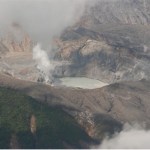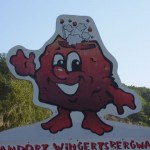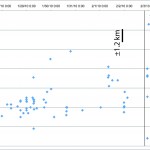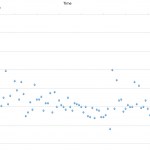caldera
Mt. Elbrus in southern Russia, one of the active volcanoes in the Caucasus Mountains. (Note the prominent flow levees sticking out of the snow cover on the dacite lava flow in the middle of the image.)
Most people (including myself) aren't fully aware of the active volcanoes in the Caucasus Mountains, but sure enough, there are volcanoes that have erupted fairly recently (geologically-speaking). One of the active volcanoes in the Caucasus Mountains of Russia is Mt. Elbrus, just north of the border with Georgia, and it has erupted as recently as ~50 A.D., which for a volcano is the blink of…
Mineral King valley in California.
Well, we are in the peak of the summer, so Eruptions will be running a bit of summer schedule while I'm off away from the interweb tubes. First off, from July 11-20, I'll be off in the mountains, doing some much-needed fieldwork with my (first) undergraduate research student. We'll be up in the Mineral King area of Sequoia National Park looking at some old rhyolites and granites - we're talking Triassic and Jurassic submarine and subaerial calderas! We'll hopefully be taking a look at zircons in these rocks to help constrain the timescales of these…
Leaving for Death Valley tomorrow - I'll be sure to take some pictures of Ubehebe Crater and the volcano at the Mirage. This will likely be the last new post until about a week from now, but look for the Erta'Ale Volcano Profile, maybe a new Mystery Volcano Photo and I'll leave a thread open for any new volcano news.
Colima in Mexico.
Eruptions reader Tim Stone sent me this image from Japanese astronaut Soichi Noguchi's Twitpic feed - it is a stunner of the caldera on Jebel Marra in Sudan. The only known historical eruption for this volcano was ~2000 BC within the Deriba Caldera, but it has…
Did I mention its a busy week?
The lava lake at Erta'Ale in 2008. Image courtesy of Stromboli Online.
Our Icelandic saga continues, with more earthquakes and more speculation/information on the parts of Eruptions readers. Keep up the discussion - I'll be fascinated to see who turns out to get closest to what actually happens, prediction-wise. The seismicity has quieted somewhat again in the last 12 hours, so we wait eagerly to see what comes next. Remember, Iceland is the land where volcanoes helped change history, so it is always fun to talk Icelandic volcanism.
The NASA Earth Observatory…
Some news for a busy Tuesday:
The crater at Poas volcano in Costa Rica, taken February 25, 2010. Image courtesy of OVSICORI by Federico Chavarria.
After the MSNBC debacle, it is nice to see some good articles on why the Chilean earthquake was overall less disastrous than the Haitian earthquake, why the tsunami wasn't as large as predicted and why these earthquakes are not abnormal. There are a lot of factors involved - the location, depth, preparedness, wealth - so the comparison can be very telling in terms of both geologic and societal issues.
The other scientific fallout from the Chilean…
News!
Toba caldera in Indonesia.
We're all still talking about the Chilean earthquake and the coverage of the event. If you happen to live in the Columbus area, you might have heard me on WTVN talking about the earthquake as well.
The Toba (Indonesia) eruption 74,000 years ago has been used by some researchers to be the cause of a "genetic bottleneck" for humans - however, that is still much debated. Currently, excavations are under away near Toba to look for evidence of human habitation that was buried by the eruption. The evidence of stone tools that appear to be made by the same human…
The Great Earthquake Swarm at Yellowstone that ushered in 2010 seems to be dying down, at least according to the USGS earthquake reports and analysis of the seismicity by the University of Utah and YVO. The daily updates on the earthquake swarms by Utah has ended. Looking at the earthquake over the last 7 days (see below), you can notice three things quickly: (1) since 2/6, there are much fewer quakes compared to a week and a half ago; (2) any sign the earthquakes were getting shallower seems to have ended; and (3) they seem to be generally smaller ( M1.5). Now, what does that mean? Like many…
We've been discussing calderas recently on Eruptions (I wonder why) and the Laacher See in Germany came up. I've actually been to the Laacher See on a field trip lead by one of the world's experts on the caldera, Dr. Gerhard Worner. So, I thought I'd post some pictures and talk a little about this feature that up until maybe 5 years ago, I didn't even know existed.
Laacher See, Germany
The Laacher See is a caldera in the Rhine Valley of Germany (see below). It is only ~30 km south of Bonn and ~60 km south of Koln (Cologne), just to the west of the Rhine River. It is part of the East Eiffel…
With all the talk of the current Yellowstone earthquake swarm, I thought it would worth it to write a post on the the structure and caldera - and why we get earthquake swarms that are structurally rather than magmatically-related.
First off, lets think about why calderas formed. This is relatively simple - at least superficially. The land (or volcano) above a magmatic system is partially supported by that magma, especially because magma is hot and buoyant. The isostatic support by the magma holds up the land surface or volcanic edifice, so when an eruption expels a large volume of magma, this…
Steaming, gurgling mudpots in the active hydrothermal system of Yellowstone.
For those of you following Yellowstone (I think there might be a few of you), I've plotted up the earthquakes since 1/27 (see below) - and sure enough, although there is a lot of scatter, they are getting shallower - however what this exactly means is unclear. You can see my plots from 1/22-28 here. As many of you have mentioned, a caldera like Yellowstone is a big interconnected system, so a solely tectonic source of this is still possible as the displacement migrates through the fractured caldera rocks.
UPDATED…
There has been a ... ahem ... healthy discussion of Yellowstone's current earthquake swarm on Eruptions as of late. We've now reached ~1,500 measurable earthquakes over the last 11 days. The latest reports of the continuation of the swarm isn't going to make anyone happy, but still, there are no signs that (a) this is out of the ordinary and (b) indicates magma making its way to the surface. In fact, if you plot the earthquakes since the 22nd of January, the depth appears to getting, well, deeper:
This plot shows the earthquakes listed on the USGS earthquake page since January 22 (oldest to…
Two quick notes:
A Costa Rican farmer evacuating in early January 2010 after renewed activity of Volcan Turrialba.
Well, it appears that after a quiet night on Friday, the current Yellowstone swarm picked up where it left off. We're now up to 1,200 earthquakes since January 17th, with a pair over M3 today. Of course, people are still uppity about the swarm, especially after the earthquake in Haiti, but really, they're about as connected as worrying about the rainy day in Boston when there was a typhoon in Malaysia. Just to get people on the same page, YVO still says: "The swarm events are…
Quick news updates for a Wednesday...
The island (and volcano) of Gran Canaria in the Atlantic Ocean. It last erupted in ~20 B.C.
The earthquakes keep coming at Yellowstone - up to a M3.5 in the last 24 hours. Time has already put up an article wondering about whether people need worry about the swarm (there might be other things to worry about before this swarm). YVO's statement on the earthquake swarm seems pretty standard (as it should be): "At this time the Yellowstone Volcano Observatory does not consider the swarm to be unusual and the earthquakes are likely related to tectonic fault…
A hot spring in Yellowstone National Park. Image courtesy of the USGS.
Yesterday I left a little teaser about the current earthquake swarm going on at the Yellowstone Caldera. Eruptions readers have come through with even more information on the swarm. Over 250 earthquakes have occurred in the park over the last few days, most between 0.5-3.1 on the Richter Scale - and getting larger each day. The swarm is centered 10 miles northwest of Old Faithful, Wyoming and 9 miles southeast of West Yellowstone. However, before everyone gets too excited, Dr. Robert Smith of University of Utah (the go-to…
Some news for today:
Yellowstone National Park, USA.
Another fine example of media headline versus actual research, an article in the Jackson Hole Daily about a new study by Dr. Robert Smith and others on the Yellowstone plume was titled "Park's giant magma plume eating up mountains". Yikes! Well, the actual study published recently in the Journal of Volcanology and Geothermal Research is more about the geophysical parameters of the Yellowstone plume - a plume that might reach as far as 500 km below the caldera itself. As for the mountain eating part, I think they were trying to get at the…
Geologic and structural map showing the extent of the Campi Flegrei caldera on the north of the Bay of Naples, Italy. Image courtesy of INGV.
One of the writing assignments I always enjoyed in high school was the "compare and contrast". You could sit back and look for stylistic differences between writers and texts - potentially offering signs about the nature of the writers motivations.
I still find it fun - case in point, two article I read about the research drilling that is about to start at the Campei Flegrei in Italy. The Campei Flegrei is a large caldera system that most recently…
Some brief tidbits for your Wednesday:
The view of Mt. Saint Helens from the Johnston Ridge Observatory.
There is a decent article about research being done at a dissected caldera system in the Italian Alps' Sesia Valley. The caldera in question is the Permian in age (248-298 million years old) so don't expect to find it in the GVP database, but the outcrops of this ancient caldera are especially well exposed, allowing for a cross section of volcano and plutonic rocks across 25 km of crustal depth (all of which is now at the surface thanks to hundreds of millions years of tectonics). It…
I knew that the minute I said I'd be back to a "regular" posting schedule that I would fail miserably, so maybe the less said, the better.
Cerro Galan caldera in Argentina (taken from space).
Thanks to all the readers who have been avidly discussing a number of fascinating topics over the weekend.
I have seen/read a little bit about the tectonic-forcing mechanism idea for some caldera-style eruptions. The biggest thing to keep in mind is that the caldera-forming event - that is to say the collapse of the roof into the chamber - isn't usually the "trigger" as much as a result of a large…
Two papers submitted, one to go. Keeps you quite busy, let me tell you.
Lava flow from a 2006 eruption on Mayon in the Philippines.
A few bits of news today:
A few more details about the ongoing watch of Mayon in the Philippines . There have been apparently no changes in the shape of the floor of the crater as you might expect if magma was rising underneath. However, there has been an overall inflation of Mayon since the unrest began a few weeks ago. PHIVOLCS will be checking the sulfur dioxide and carbon dioxide output of the volcano soon as well.
Lots of articles this week about the "…
Chaiten in Chile erupting in January 2009. Even after over a year of activity, Eruptions readers are still captivated by the volcano.
Thanks for sending me your questions about volcanoes and volcanism. I'll try to tackle some hear - but as always, keep the questions coming! Send them to
For those of you who have submitted a question but don't see the answer here, do not fret. Likely it just means that I needed to do a little more research into the question and will get to it in a later mailbag!
So, without further ado ...
Mark M.: Here in the Appalachians we have very dense crystalline rock…




